Management and Operations: Roles of Leaders and Managers in Business
VerifiedAdded on 2020/06/06
|13
|4213
|49
Report
AI Summary
This report delves into the realms of management and operations, with a specific focus on the roles of leaders and managers within a business context, using Marks & Spencer (M&S) as a case study. It elucidates the distinct characteristics and responsibilities of leaders and managers, exploring their functions in diverse organizational scenarios. The report examines various leadership theories and models, including situational, systems, and contingency leadership, highlighting their practical applications. Furthermore, it investigates key approaches to operations management, emphasizing the significance of operational management within an organization. It also considers the influence of the business environment on leadership, management, and decision-making processes. The report culminates in an analysis of the strengths and weaknesses of leadership approaches, providing a comprehensive understanding of effective management and leadership strategies.
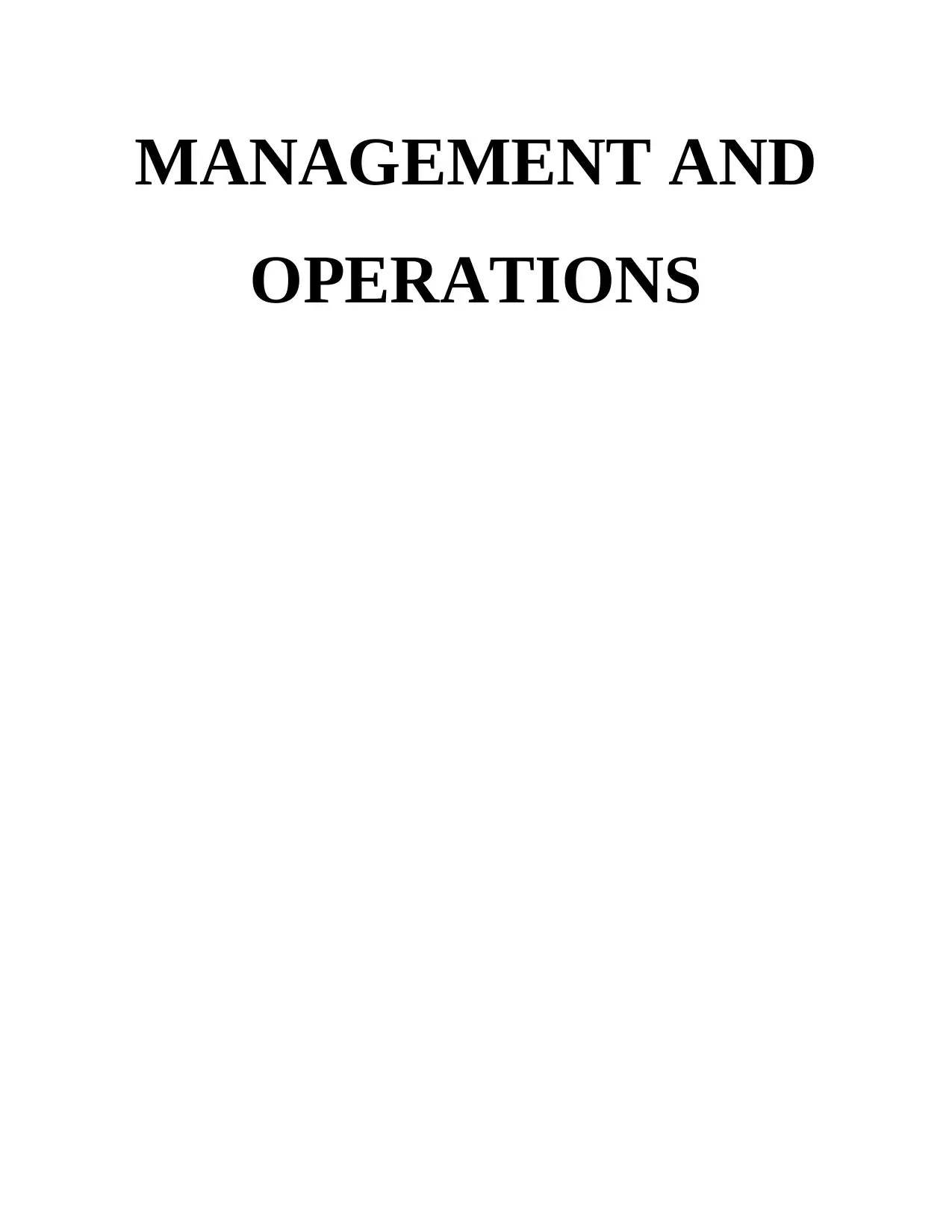
MANAGEMENT AND
OPERATIONS
OPERATIONS
Paraphrase This Document
Need a fresh take? Get an instant paraphrase of this document with our AI Paraphraser
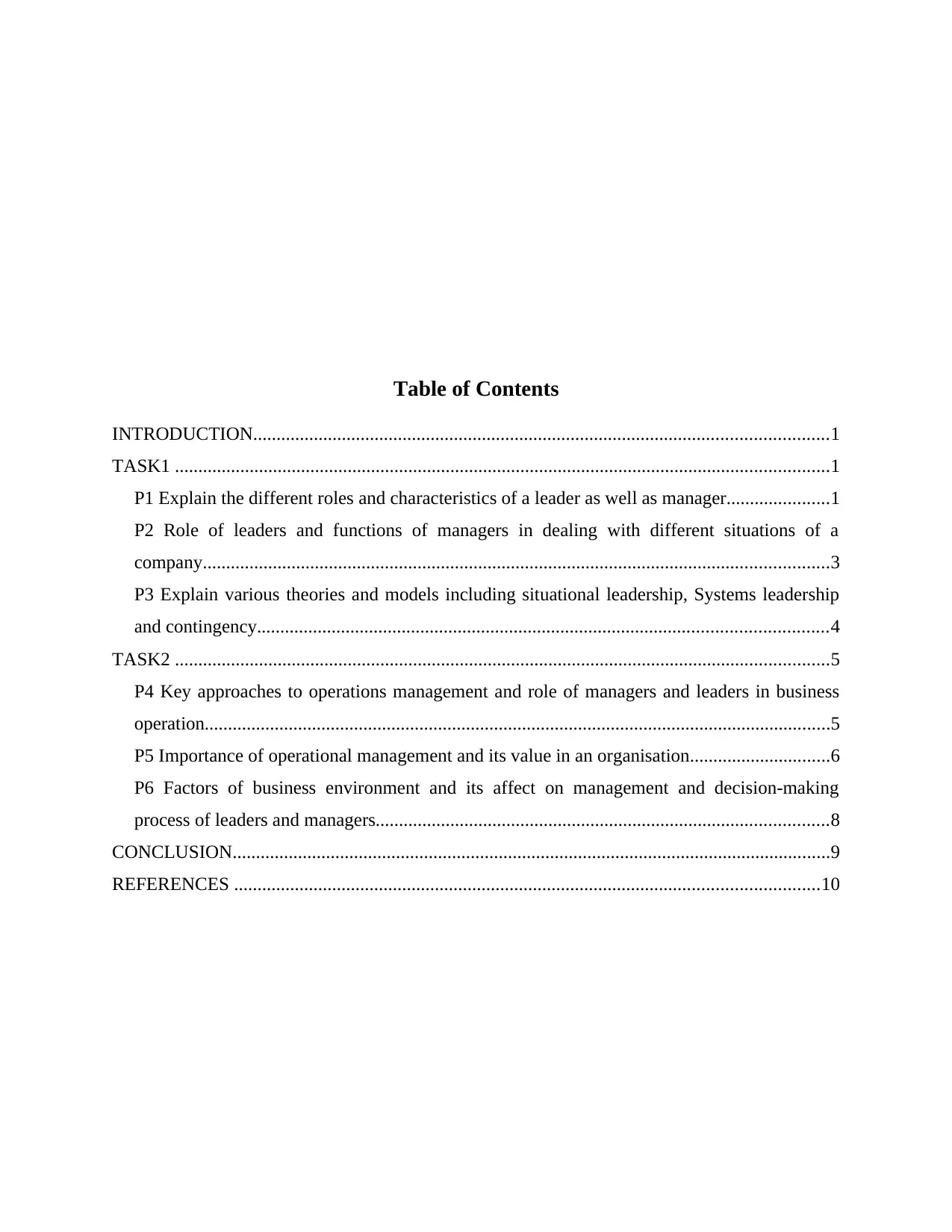
Table of Contents
INTRODUCTION...........................................................................................................................1
TASK1 ............................................................................................................................................1
P1 Explain the different roles and characteristics of a leader as well as manager......................1
P2 Role of leaders and functions of managers in dealing with different situations of a
company......................................................................................................................................3
P3 Explain various theories and models including situational leadership, Systems leadership
and contingency..........................................................................................................................4
TASK2 ............................................................................................................................................5
P4 Key approaches to operations management and role of managers and leaders in business
operation......................................................................................................................................5
P5 Importance of operational management and its value in an organisation..............................6
P6 Factors of business environment and its affect on management and decision-making
process of leaders and managers.................................................................................................8
CONCLUSION................................................................................................................................9
REFERENCES .............................................................................................................................10
INTRODUCTION...........................................................................................................................1
TASK1 ............................................................................................................................................1
P1 Explain the different roles and characteristics of a leader as well as manager......................1
P2 Role of leaders and functions of managers in dealing with different situations of a
company......................................................................................................................................3
P3 Explain various theories and models including situational leadership, Systems leadership
and contingency..........................................................................................................................4
TASK2 ............................................................................................................................................5
P4 Key approaches to operations management and role of managers and leaders in business
operation......................................................................................................................................5
P5 Importance of operational management and its value in an organisation..............................6
P6 Factors of business environment and its affect on management and decision-making
process of leaders and managers.................................................................................................8
CONCLUSION................................................................................................................................9
REFERENCES .............................................................................................................................10
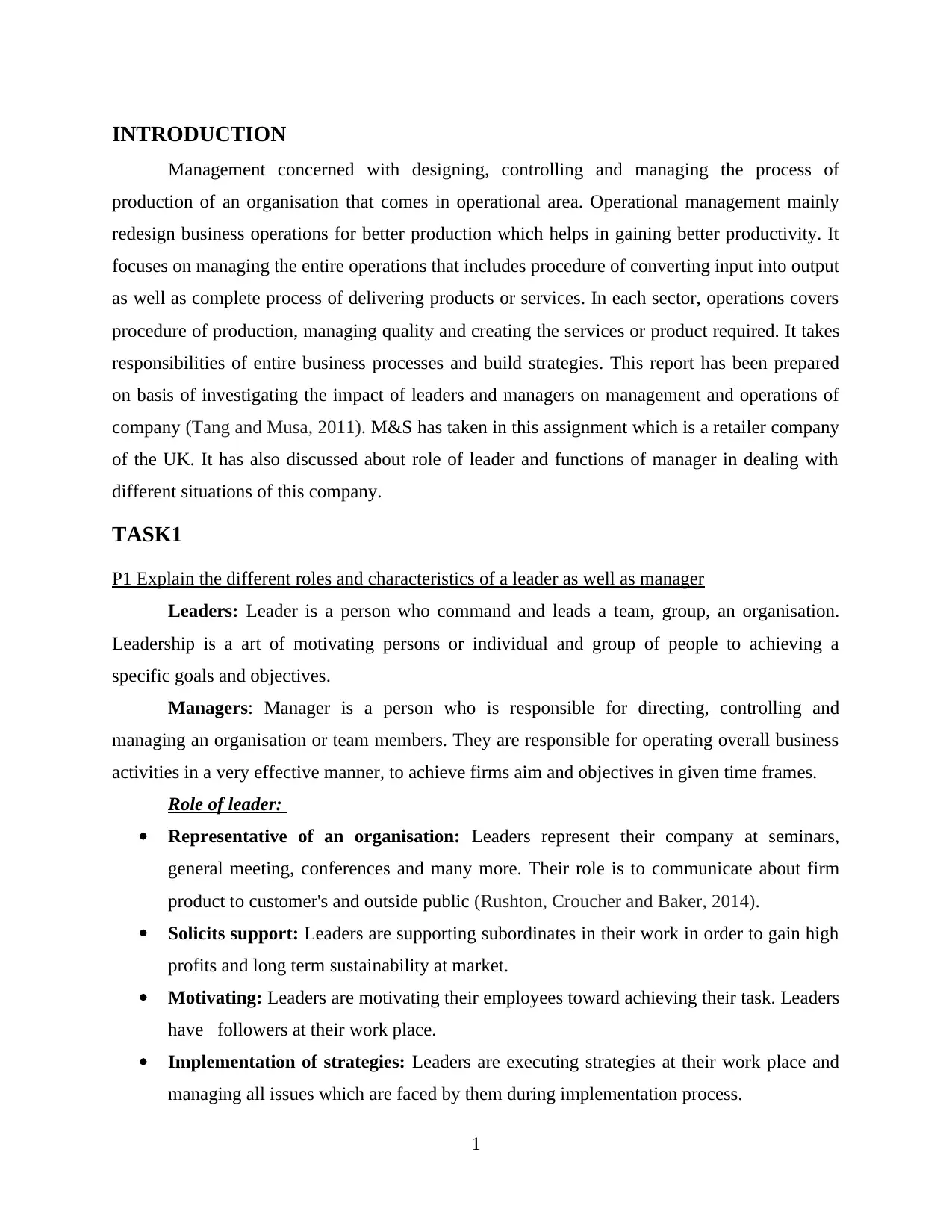
INTRODUCTION
Management concerned with designing, controlling and managing the process of
production of an organisation that comes in operational area. Operational management mainly
redesign business operations for better production which helps in gaining better productivity. It
focuses on managing the entire operations that includes procedure of converting input into output
as well as complete process of delivering products or services. In each sector, operations covers
procedure of production, managing quality and creating the services or product required. It takes
responsibilities of entire business processes and build strategies. This report has been prepared
on basis of investigating the impact of leaders and managers on management and operations of
company (Tang and Musa, 2011). M&S has taken in this assignment which is a retailer company
of the UK. It has also discussed about role of leader and functions of manager in dealing with
different situations of this company.
TASK1
P1 Explain the different roles and characteristics of a leader as well as manager
Leaders: Leader is a person who command and leads a team, group, an organisation.
Leadership is a art of motivating persons or individual and group of people to achieving a
specific goals and objectives.
Managers: Manager is a person who is responsible for directing, controlling and
managing an organisation or team members. They are responsible for operating overall business
activities in a very effective manner, to achieve firms aim and objectives in given time frames.
Role of leader:
Representative of an organisation: Leaders represent their company at seminars,
general meeting, conferences and many more. Their role is to communicate about firm
product to customer's and outside public (Rushton, Croucher and Baker, 2014).
Solicits support: Leaders are supporting subordinates in their work in order to gain high
profits and long term sustainability at market.
Motivating: Leaders are motivating their employees toward achieving their task. Leaders
have followers at their work place.
Implementation of strategies: Leaders are executing strategies at their work place and
managing all issues which are faced by them during implementation process.
1
Management concerned with designing, controlling and managing the process of
production of an organisation that comes in operational area. Operational management mainly
redesign business operations for better production which helps in gaining better productivity. It
focuses on managing the entire operations that includes procedure of converting input into output
as well as complete process of delivering products or services. In each sector, operations covers
procedure of production, managing quality and creating the services or product required. It takes
responsibilities of entire business processes and build strategies. This report has been prepared
on basis of investigating the impact of leaders and managers on management and operations of
company (Tang and Musa, 2011). M&S has taken in this assignment which is a retailer company
of the UK. It has also discussed about role of leader and functions of manager in dealing with
different situations of this company.
TASK1
P1 Explain the different roles and characteristics of a leader as well as manager
Leaders: Leader is a person who command and leads a team, group, an organisation.
Leadership is a art of motivating persons or individual and group of people to achieving a
specific goals and objectives.
Managers: Manager is a person who is responsible for directing, controlling and
managing an organisation or team members. They are responsible for operating overall business
activities in a very effective manner, to achieve firms aim and objectives in given time frames.
Role of leader:
Representative of an organisation: Leaders represent their company at seminars,
general meeting, conferences and many more. Their role is to communicate about firm
product to customer's and outside public (Rushton, Croucher and Baker, 2014).
Solicits support: Leaders are supporting subordinates in their work in order to gain high
profits and long term sustainability at market.
Motivating: Leaders are motivating their employees toward achieving their task. Leaders
have followers at their work place.
Implementation of strategies: Leaders are executing strategies at their work place and
managing all issues which are faced by them during implementation process.
1
⊘ This is a preview!⊘
Do you want full access?
Subscribe today to unlock all pages.

Trusted by 1+ million students worldwide
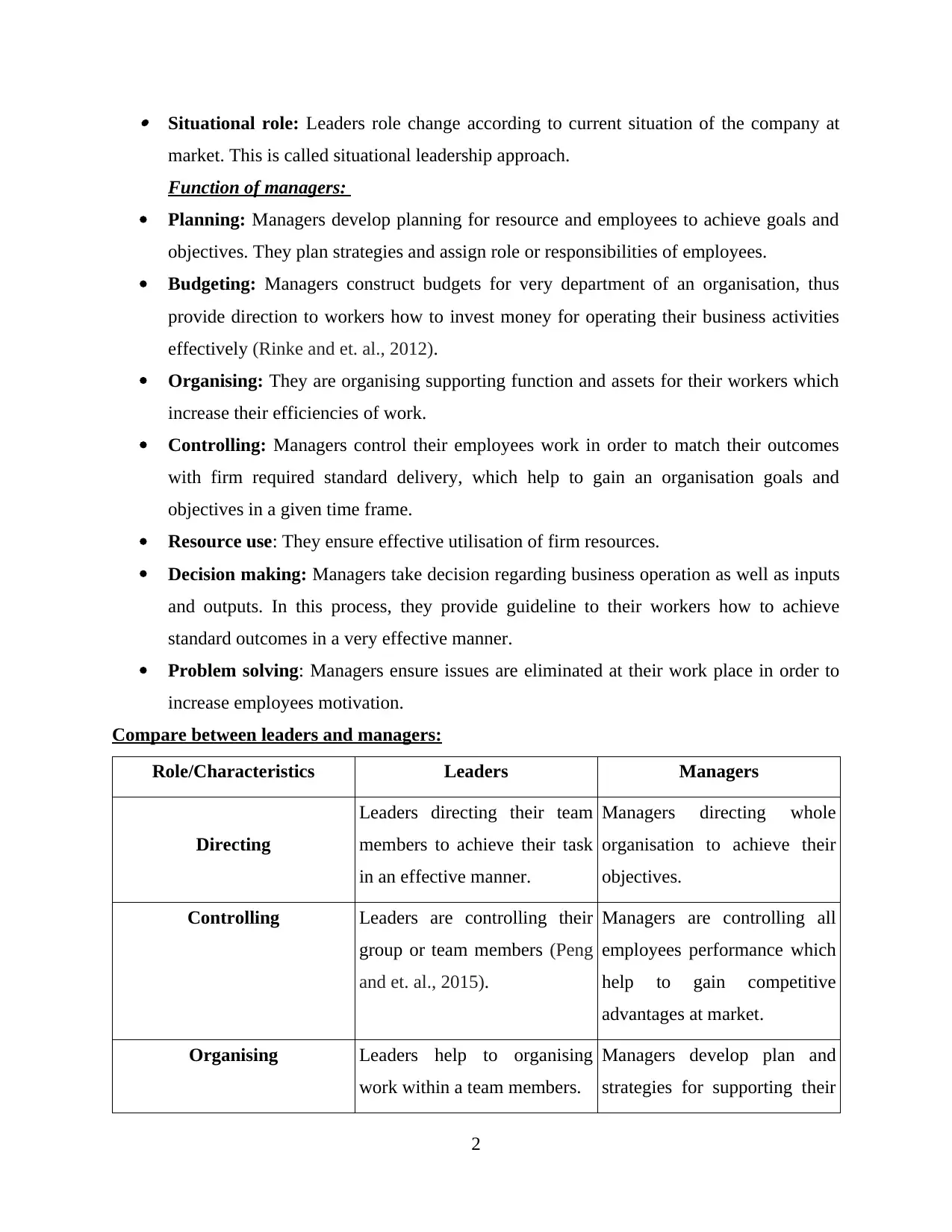
Situational role: Leaders role change according to current situation of the company at
market. This is called situational leadership approach.
Function of managers:
Planning: Managers develop planning for resource and employees to achieve goals and
objectives. They plan strategies and assign role or responsibilities of employees.
Budgeting: Managers construct budgets for very department of an organisation, thus
provide direction to workers how to invest money for operating their business activities
effectively (Rinke and et. al., 2012).
Organising: They are organising supporting function and assets for their workers which
increase their efficiencies of work.
Controlling: Managers control their employees work in order to match their outcomes
with firm required standard delivery, which help to gain an organisation goals and
objectives in a given time frame.
Resource use: They ensure effective utilisation of firm resources.
Decision making: Managers take decision regarding business operation as well as inputs
and outputs. In this process, they provide guideline to their workers how to achieve
standard outcomes in a very effective manner.
Problem solving: Managers ensure issues are eliminated at their work place in order to
increase employees motivation.
Compare between leaders and managers:
Role/Characteristics Leaders Managers
Directing
Leaders directing their team
members to achieve their task
in an effective manner.
Managers directing whole
organisation to achieve their
objectives.
Controlling Leaders are controlling their
group or team members (Peng
and et. al., 2015).
Managers are controlling all
employees performance which
help to gain competitive
advantages at market.
Organising Leaders help to organising
work within a team members.
Managers develop plan and
strategies for supporting their
2
market. This is called situational leadership approach.
Function of managers:
Planning: Managers develop planning for resource and employees to achieve goals and
objectives. They plan strategies and assign role or responsibilities of employees.
Budgeting: Managers construct budgets for very department of an organisation, thus
provide direction to workers how to invest money for operating their business activities
effectively (Rinke and et. al., 2012).
Organising: They are organising supporting function and assets for their workers which
increase their efficiencies of work.
Controlling: Managers control their employees work in order to match their outcomes
with firm required standard delivery, which help to gain an organisation goals and
objectives in a given time frame.
Resource use: They ensure effective utilisation of firm resources.
Decision making: Managers take decision regarding business operation as well as inputs
and outputs. In this process, they provide guideline to their workers how to achieve
standard outcomes in a very effective manner.
Problem solving: Managers ensure issues are eliminated at their work place in order to
increase employees motivation.
Compare between leaders and managers:
Role/Characteristics Leaders Managers
Directing
Leaders directing their team
members to achieve their task
in an effective manner.
Managers directing whole
organisation to achieve their
objectives.
Controlling Leaders are controlling their
group or team members (Peng
and et. al., 2015).
Managers are controlling all
employees performance which
help to gain competitive
advantages at market.
Organising Leaders help to organising
work within a team members.
Managers develop plan and
strategies for supporting their
2
Paraphrase This Document
Need a fresh take? Get an instant paraphrase of this document with our AI Paraphraser
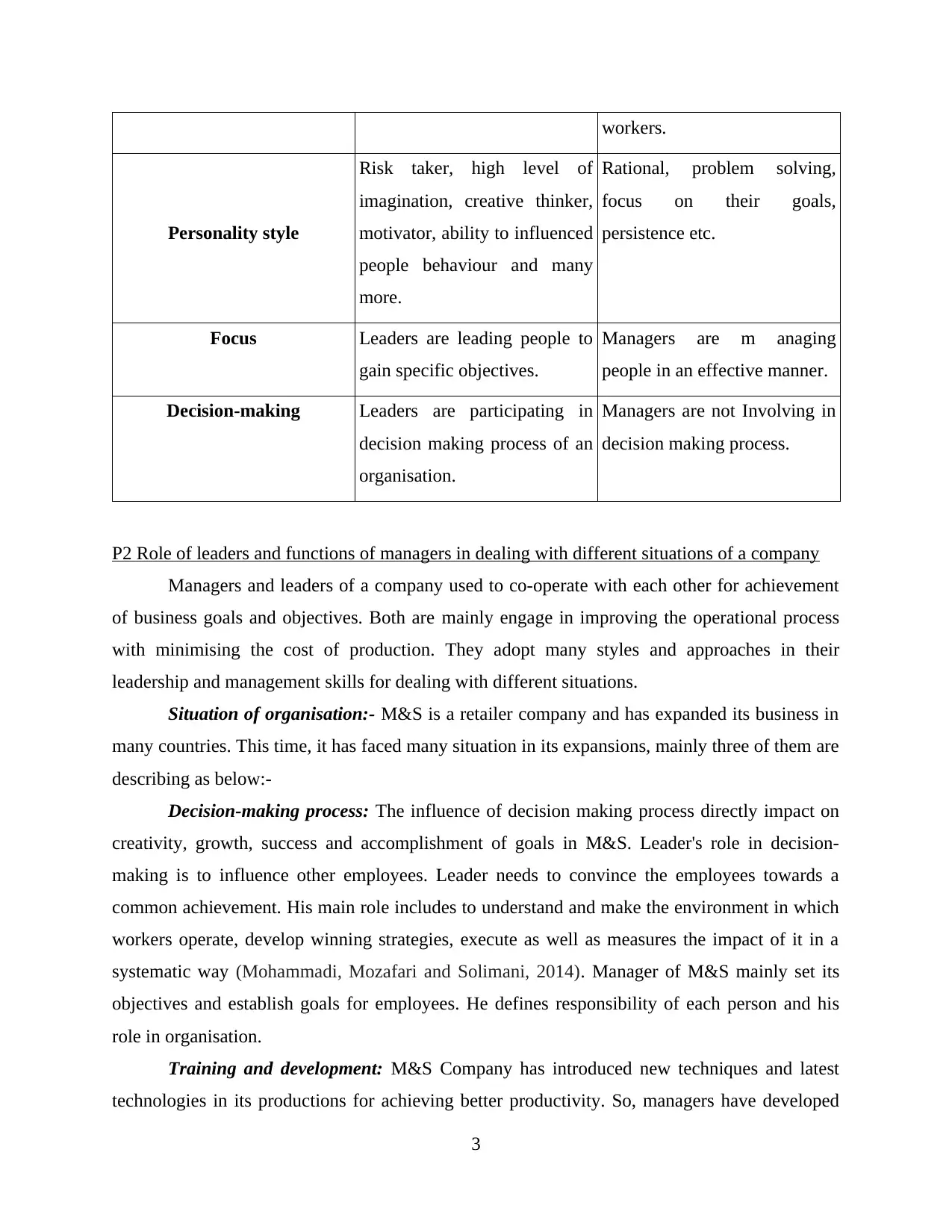
workers.
Personality style
Risk taker, high level of
imagination, creative thinker,
motivator, ability to influenced
people behaviour and many
more.
Rational, problem solving,
focus on their goals,
persistence etc.
Focus Leaders are leading people to
gain specific objectives.
Managers are m anaging
people in an effective manner.
Decision-making Leaders are participating in
decision making process of an
organisation.
Managers are not Involving in
decision making process.
P2 Role of leaders and functions of managers in dealing with different situations of a company
Managers and leaders of a company used to co-operate with each other for achievement
of business goals and objectives. Both are mainly engage in improving the operational process
with minimising the cost of production. They adopt many styles and approaches in their
leadership and management skills for dealing with different situations.
Situation of organisation:- M&S is a retailer company and has expanded its business in
many countries. This time, it has faced many situation in its expansions, mainly three of them are
describing as below:-
Decision-making process: The influence of decision making process directly impact on
creativity, growth, success and accomplishment of goals in M&S. Leader's role in decision-
making is to influence other employees. Leader needs to convince the employees towards a
common achievement. His main role includes to understand and make the environment in which
workers operate, develop winning strategies, execute as well as measures the impact of it in a
systematic way (Mohammadi, Mozafari and Solimani, 2014). Manager of M&S mainly set its
objectives and establish goals for employees. He defines responsibility of each person and his
role in organisation.
Training and development: M&S Company has introduced new techniques and latest
technologies in its productions for achieving better productivity. So, managers have developed
3
Personality style
Risk taker, high level of
imagination, creative thinker,
motivator, ability to influenced
people behaviour and many
more.
Rational, problem solving,
focus on their goals,
persistence etc.
Focus Leaders are leading people to
gain specific objectives.
Managers are m anaging
people in an effective manner.
Decision-making Leaders are participating in
decision making process of an
organisation.
Managers are not Involving in
decision making process.
P2 Role of leaders and functions of managers in dealing with different situations of a company
Managers and leaders of a company used to co-operate with each other for achievement
of business goals and objectives. Both are mainly engage in improving the operational process
with minimising the cost of production. They adopt many styles and approaches in their
leadership and management skills for dealing with different situations.
Situation of organisation:- M&S is a retailer company and has expanded its business in
many countries. This time, it has faced many situation in its expansions, mainly three of them are
describing as below:-
Decision-making process: The influence of decision making process directly impact on
creativity, growth, success and accomplishment of goals in M&S. Leader's role in decision-
making is to influence other employees. Leader needs to convince the employees towards a
common achievement. His main role includes to understand and make the environment in which
workers operate, develop winning strategies, execute as well as measures the impact of it in a
systematic way (Mohammadi, Mozafari and Solimani, 2014). Manager of M&S mainly set its
objectives and establish goals for employees. He defines responsibility of each person and his
role in organisation.
Training and development: M&S Company has introduced new techniques and latest
technologies in its productions for achieving better productivity. So, managers have developed
3
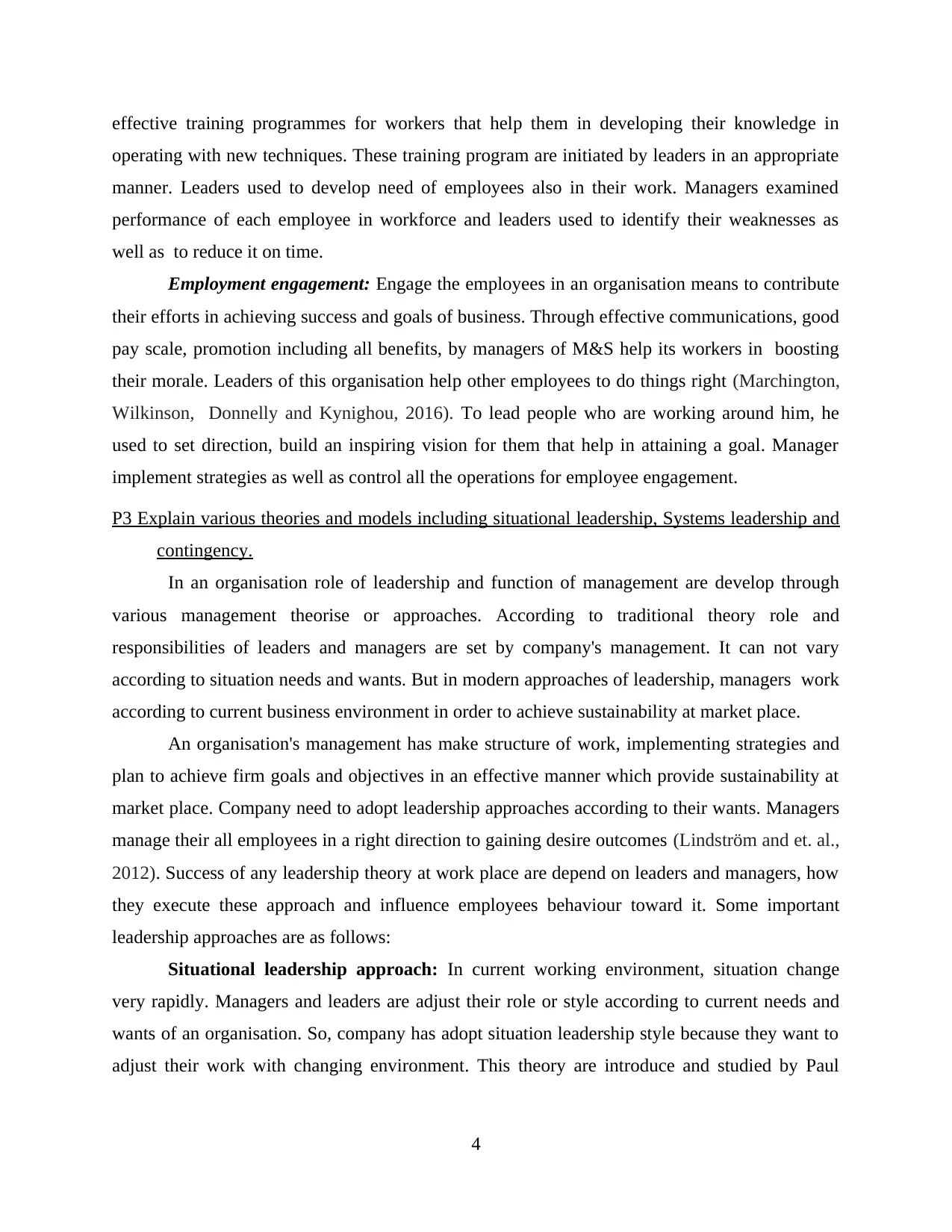
effective training programmes for workers that help them in developing their knowledge in
operating with new techniques. These training program are initiated by leaders in an appropriate
manner. Leaders used to develop need of employees also in their work. Managers examined
performance of each employee in workforce and leaders used to identify their weaknesses as
well as to reduce it on time.
Employment engagement: Engage the employees in an organisation means to contribute
their efforts in achieving success and goals of business. Through effective communications, good
pay scale, promotion including all benefits, by managers of M&S help its workers in boosting
their morale. Leaders of this organisation help other employees to do things right (Marchington,
Wilkinson, Donnelly and Kynighou, 2016). To lead people who are working around him, he
used to set direction, build an inspiring vision for them that help in attaining a goal. Manager
implement strategies as well as control all the operations for employee engagement.
P3 Explain various theories and models including situational leadership, Systems leadership and
contingency.
In an organisation role of leadership and function of management are develop through
various management theorise or approaches. According to traditional theory role and
responsibilities of leaders and managers are set by company's management. It can not vary
according to situation needs and wants. But in modern approaches of leadership, managers work
according to current business environment in order to achieve sustainability at market place.
An organisation's management has make structure of work, implementing strategies and
plan to achieve firm goals and objectives in an effective manner which provide sustainability at
market place. Company need to adopt leadership approaches according to their wants. Managers
manage their all employees in a right direction to gaining desire outcomes (Lindström and et. al.,
2012). Success of any leadership theory at work place are depend on leaders and managers, how
they execute these approach and influence employees behaviour toward it. Some important
leadership approaches are as follows:
Situational leadership approach: In current working environment, situation change
very rapidly. Managers and leaders are adjust their role or style according to current needs and
wants of an organisation. So, company has adopt situation leadership style because they want to
adjust their work with changing environment. This theory are introduce and studied by Paul
4
operating with new techniques. These training program are initiated by leaders in an appropriate
manner. Leaders used to develop need of employees also in their work. Managers examined
performance of each employee in workforce and leaders used to identify their weaknesses as
well as to reduce it on time.
Employment engagement: Engage the employees in an organisation means to contribute
their efforts in achieving success and goals of business. Through effective communications, good
pay scale, promotion including all benefits, by managers of M&S help its workers in boosting
their morale. Leaders of this organisation help other employees to do things right (Marchington,
Wilkinson, Donnelly and Kynighou, 2016). To lead people who are working around him, he
used to set direction, build an inspiring vision for them that help in attaining a goal. Manager
implement strategies as well as control all the operations for employee engagement.
P3 Explain various theories and models including situational leadership, Systems leadership and
contingency.
In an organisation role of leadership and function of management are develop through
various management theorise or approaches. According to traditional theory role and
responsibilities of leaders and managers are set by company's management. It can not vary
according to situation needs and wants. But in modern approaches of leadership, managers work
according to current business environment in order to achieve sustainability at market place.
An organisation's management has make structure of work, implementing strategies and
plan to achieve firm goals and objectives in an effective manner which provide sustainability at
market place. Company need to adopt leadership approaches according to their wants. Managers
manage their all employees in a right direction to gaining desire outcomes (Lindström and et. al.,
2012). Success of any leadership theory at work place are depend on leaders and managers, how
they execute these approach and influence employees behaviour toward it. Some important
leadership approaches are as follows:
Situational leadership approach: In current working environment, situation change
very rapidly. Managers and leaders are adjust their role or style according to current needs and
wants of an organisation. So, company has adopt situation leadership style because they want to
adjust their work with changing environment. This theory are introduce and studied by Paul
4
⊘ This is a preview!⊘
Do you want full access?
Subscribe today to unlock all pages.

Trusted by 1+ million students worldwide
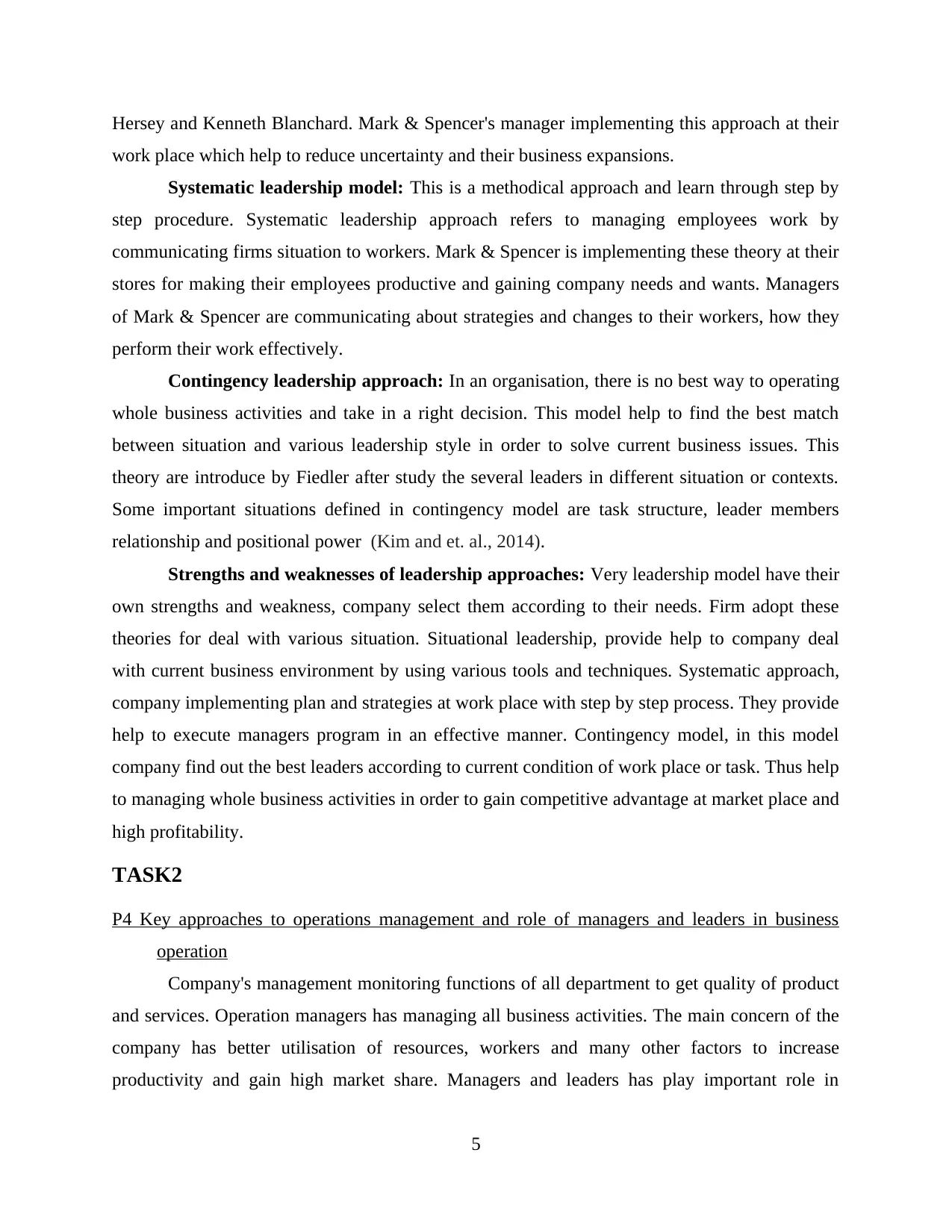
Hersey and Kenneth Blanchard. Mark & Spencer's manager implementing this approach at their
work place which help to reduce uncertainty and their business expansions.
Systematic leadership model: This is a methodical approach and learn through step by
step procedure. Systematic leadership approach refers to managing employees work by
communicating firms situation to workers. Mark & Spencer is implementing these theory at their
stores for making their employees productive and gaining company needs and wants. Managers
of Mark & Spencer are communicating about strategies and changes to their workers, how they
perform their work effectively.
Contingency leadership approach: In an organisation, there is no best way to operating
whole business activities and take in a right decision. This model help to find the best match
between situation and various leadership style in order to solve current business issues. This
theory are introduce by Fiedler after study the several leaders in different situation or contexts.
Some important situations defined in contingency model are task structure, leader members
relationship and positional power (Kim and et. al., 2014).
Strengths and weaknesses of leadership approaches: Very leadership model have their
own strengths and weakness, company select them according to their needs. Firm adopt these
theories for deal with various situation. Situational leadership, provide help to company deal
with current business environment by using various tools and techniques. Systematic approach,
company implementing plan and strategies at work place with step by step process. They provide
help to execute managers program in an effective manner. Contingency model, in this model
company find out the best leaders according to current condition of work place or task. Thus help
to managing whole business activities in order to gain competitive advantage at market place and
high profitability.
TASK2
P4 Key approaches to operations management and role of managers and leaders in business
operation
Company's management monitoring functions of all department to get quality of product
and services. Operation managers has managing all business activities. The main concern of the
company has better utilisation of resources, workers and many other factors to increase
productivity and gain high market share. Managers and leaders has play important role in
5
work place which help to reduce uncertainty and their business expansions.
Systematic leadership model: This is a methodical approach and learn through step by
step procedure. Systematic leadership approach refers to managing employees work by
communicating firms situation to workers. Mark & Spencer is implementing these theory at their
stores for making their employees productive and gaining company needs and wants. Managers
of Mark & Spencer are communicating about strategies and changes to their workers, how they
perform their work effectively.
Contingency leadership approach: In an organisation, there is no best way to operating
whole business activities and take in a right decision. This model help to find the best match
between situation and various leadership style in order to solve current business issues. This
theory are introduce by Fiedler after study the several leaders in different situation or contexts.
Some important situations defined in contingency model are task structure, leader members
relationship and positional power (Kim and et. al., 2014).
Strengths and weaknesses of leadership approaches: Very leadership model have their
own strengths and weakness, company select them according to their needs. Firm adopt these
theories for deal with various situation. Situational leadership, provide help to company deal
with current business environment by using various tools and techniques. Systematic approach,
company implementing plan and strategies at work place with step by step process. They provide
help to execute managers program in an effective manner. Contingency model, in this model
company find out the best leaders according to current condition of work place or task. Thus help
to managing whole business activities in order to gain competitive advantage at market place and
high profitability.
TASK2
P4 Key approaches to operations management and role of managers and leaders in business
operation
Company's management monitoring functions of all department to get quality of product
and services. Operation managers has managing all business activities. The main concern of the
company has better utilisation of resources, workers and many other factors to increase
productivity and gain high market share. Managers and leaders has play important role in
5
Paraphrase This Document
Need a fresh take? Get an instant paraphrase of this document with our AI Paraphraser
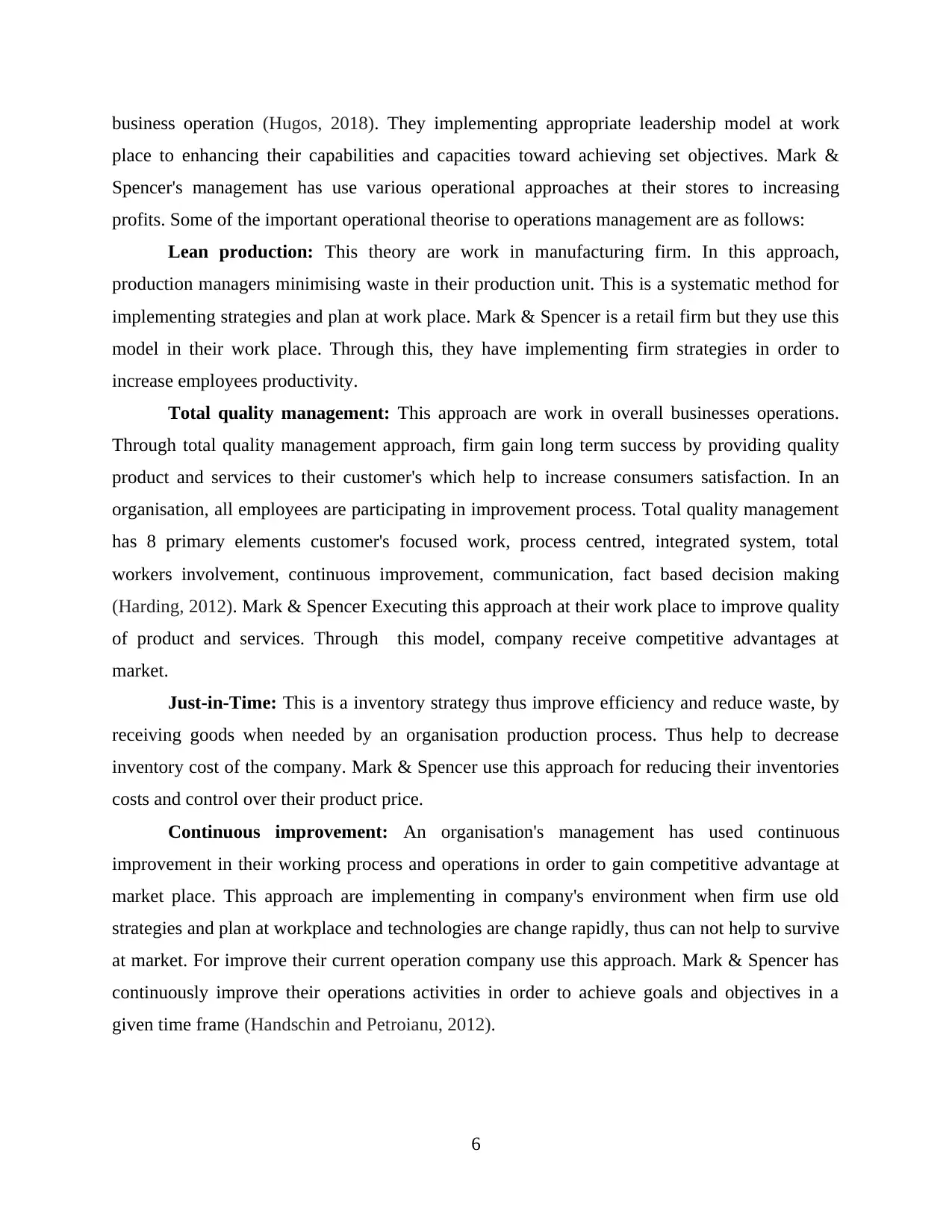
business operation (Hugos, 2018). They implementing appropriate leadership model at work
place to enhancing their capabilities and capacities toward achieving set objectives. Mark &
Spencer's management has use various operational approaches at their stores to increasing
profits. Some of the important operational theorise to operations management are as follows:
Lean production: This theory are work in manufacturing firm. In this approach,
production managers minimising waste in their production unit. This is a systematic method for
implementing strategies and plan at work place. Mark & Spencer is a retail firm but they use this
model in their work place. Through this, they have implementing firm strategies in order to
increase employees productivity.
Total quality management: This approach are work in overall businesses operations.
Through total quality management approach, firm gain long term success by providing quality
product and services to their customer's which help to increase consumers satisfaction. In an
organisation, all employees are participating in improvement process. Total quality management
has 8 primary elements customer's focused work, process centred, integrated system, total
workers involvement, continuous improvement, communication, fact based decision making
(Harding, 2012). Mark & Spencer Executing this approach at their work place to improve quality
of product and services. Through this model, company receive competitive advantages at
market.
Just-in-Time: This is a inventory strategy thus improve efficiency and reduce waste, by
receiving goods when needed by an organisation production process. Thus help to decrease
inventory cost of the company. Mark & Spencer use this approach for reducing their inventories
costs and control over their product price.
Continuous improvement: An organisation's management has used continuous
improvement in their working process and operations in order to gain competitive advantage at
market place. This approach are implementing in company's environment when firm use old
strategies and plan at workplace and technologies are change rapidly, thus can not help to survive
at market. For improve their current operation company use this approach. Mark & Spencer has
continuously improve their operations activities in order to achieve goals and objectives in a
given time frame (Handschin and Petroianu, 2012).
6
place to enhancing their capabilities and capacities toward achieving set objectives. Mark &
Spencer's management has use various operational approaches at their stores to increasing
profits. Some of the important operational theorise to operations management are as follows:
Lean production: This theory are work in manufacturing firm. In this approach,
production managers minimising waste in their production unit. This is a systematic method for
implementing strategies and plan at work place. Mark & Spencer is a retail firm but they use this
model in their work place. Through this, they have implementing firm strategies in order to
increase employees productivity.
Total quality management: This approach are work in overall businesses operations.
Through total quality management approach, firm gain long term success by providing quality
product and services to their customer's which help to increase consumers satisfaction. In an
organisation, all employees are participating in improvement process. Total quality management
has 8 primary elements customer's focused work, process centred, integrated system, total
workers involvement, continuous improvement, communication, fact based decision making
(Harding, 2012). Mark & Spencer Executing this approach at their work place to improve quality
of product and services. Through this model, company receive competitive advantages at
market.
Just-in-Time: This is a inventory strategy thus improve efficiency and reduce waste, by
receiving goods when needed by an organisation production process. Thus help to decrease
inventory cost of the company. Mark & Spencer use this approach for reducing their inventories
costs and control over their product price.
Continuous improvement: An organisation's management has used continuous
improvement in their working process and operations in order to gain competitive advantage at
market place. This approach are implementing in company's environment when firm use old
strategies and plan at workplace and technologies are change rapidly, thus can not help to survive
at market. For improve their current operation company use this approach. Mark & Spencer has
continuously improve their operations activities in order to achieve goals and objectives in a
given time frame (Handschin and Petroianu, 2012).
6
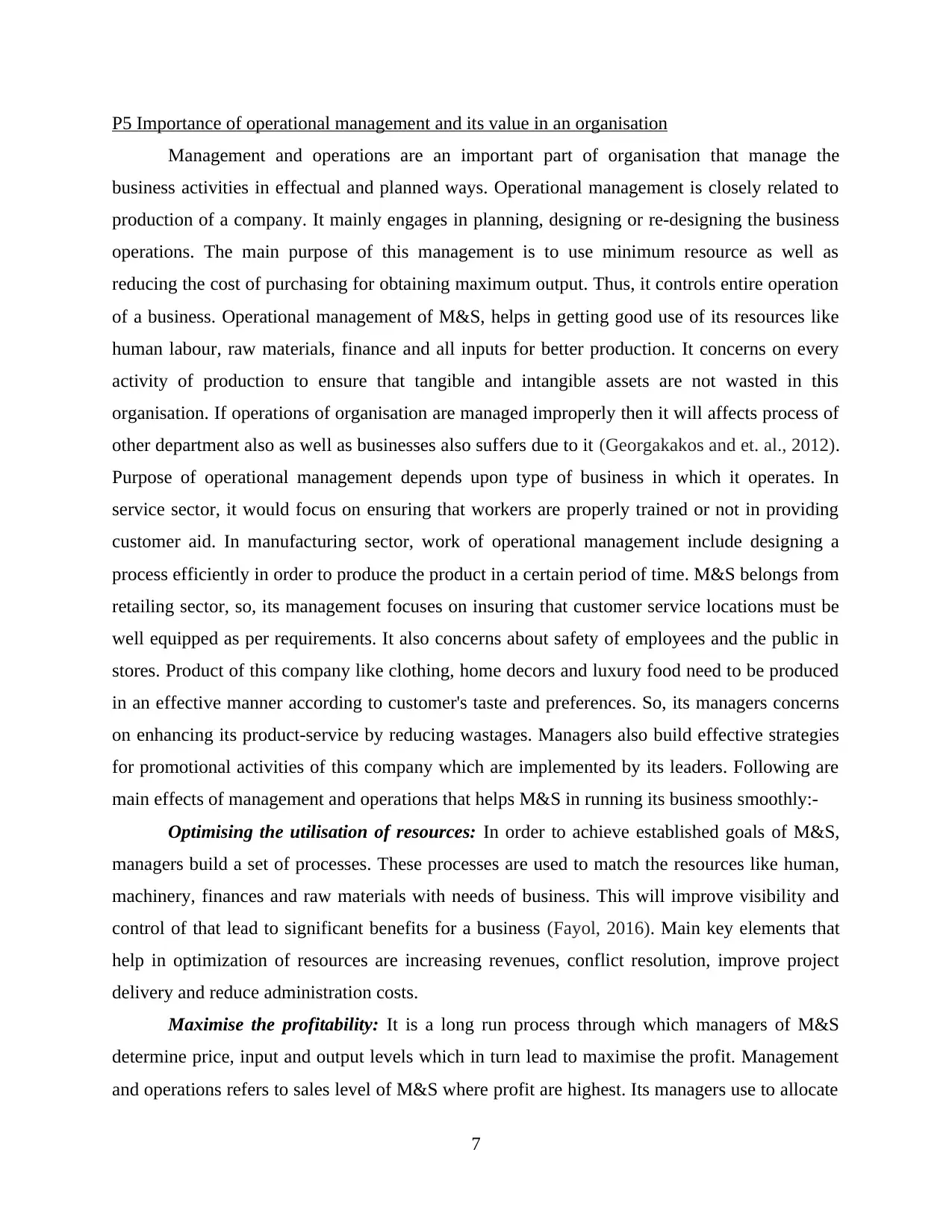
P5 Importance of operational management and its value in an organisation
Management and operations are an important part of organisation that manage the
business activities in effectual and planned ways. Operational management is closely related to
production of a company. It mainly engages in planning, designing or re-designing the business
operations. The main purpose of this management is to use minimum resource as well as
reducing the cost of purchasing for obtaining maximum output. Thus, it controls entire operation
of a business. Operational management of M&S, helps in getting good use of its resources like
human labour, raw materials, finance and all inputs for better production. It concerns on every
activity of production to ensure that tangible and intangible assets are not wasted in this
organisation. If operations of organisation are managed improperly then it will affects process of
other department also as well as businesses also suffers due to it (Georgakakos and et. al., 2012).
Purpose of operational management depends upon type of business in which it operates. In
service sector, it would focus on ensuring that workers are properly trained or not in providing
customer aid. In manufacturing sector, work of operational management include designing a
process efficiently in order to produce the product in a certain period of time. M&S belongs from
retailing sector, so, its management focuses on insuring that customer service locations must be
well equipped as per requirements. It also concerns about safety of employees and the public in
stores. Product of this company like clothing, home decors and luxury food need to be produced
in an effective manner according to customer's taste and preferences. So, its managers concerns
on enhancing its product-service by reducing wastages. Managers also build effective strategies
for promotional activities of this company which are implemented by its leaders. Following are
main effects of management and operations that helps M&S in running its business smoothly:-
Optimising the utilisation of resources: In order to achieve established goals of M&S,
managers build a set of processes. These processes are used to match the resources like human,
machinery, finances and raw materials with needs of business. This will improve visibility and
control of that lead to significant benefits for a business (Fayol, 2016). Main key elements that
help in optimization of resources are increasing revenues, conflict resolution, improve project
delivery and reduce administration costs.
Maximise the profitability: It is a long run process through which managers of M&S
determine price, input and output levels which in turn lead to maximise the profit. Management
and operations refers to sales level of M&S where profit are highest. Its managers use to allocate
7
Management and operations are an important part of organisation that manage the
business activities in effectual and planned ways. Operational management is closely related to
production of a company. It mainly engages in planning, designing or re-designing the business
operations. The main purpose of this management is to use minimum resource as well as
reducing the cost of purchasing for obtaining maximum output. Thus, it controls entire operation
of a business. Operational management of M&S, helps in getting good use of its resources like
human labour, raw materials, finance and all inputs for better production. It concerns on every
activity of production to ensure that tangible and intangible assets are not wasted in this
organisation. If operations of organisation are managed improperly then it will affects process of
other department also as well as businesses also suffers due to it (Georgakakos and et. al., 2012).
Purpose of operational management depends upon type of business in which it operates. In
service sector, it would focus on ensuring that workers are properly trained or not in providing
customer aid. In manufacturing sector, work of operational management include designing a
process efficiently in order to produce the product in a certain period of time. M&S belongs from
retailing sector, so, its management focuses on insuring that customer service locations must be
well equipped as per requirements. It also concerns about safety of employees and the public in
stores. Product of this company like clothing, home decors and luxury food need to be produced
in an effective manner according to customer's taste and preferences. So, its managers concerns
on enhancing its product-service by reducing wastages. Managers also build effective strategies
for promotional activities of this company which are implemented by its leaders. Following are
main effects of management and operations that helps M&S in running its business smoothly:-
Optimising the utilisation of resources: In order to achieve established goals of M&S,
managers build a set of processes. These processes are used to match the resources like human,
machinery, finances and raw materials with needs of business. This will improve visibility and
control of that lead to significant benefits for a business (Fayol, 2016). Main key elements that
help in optimization of resources are increasing revenues, conflict resolution, improve project
delivery and reduce administration costs.
Maximise the profitability: It is a long run process through which managers of M&S
determine price, input and output levels which in turn lead to maximise the profit. Management
and operations refers to sales level of M&S where profit are highest. Its managers use to allocate
7
⊘ This is a preview!⊘
Do you want full access?
Subscribe today to unlock all pages.

Trusted by 1+ million students worldwide
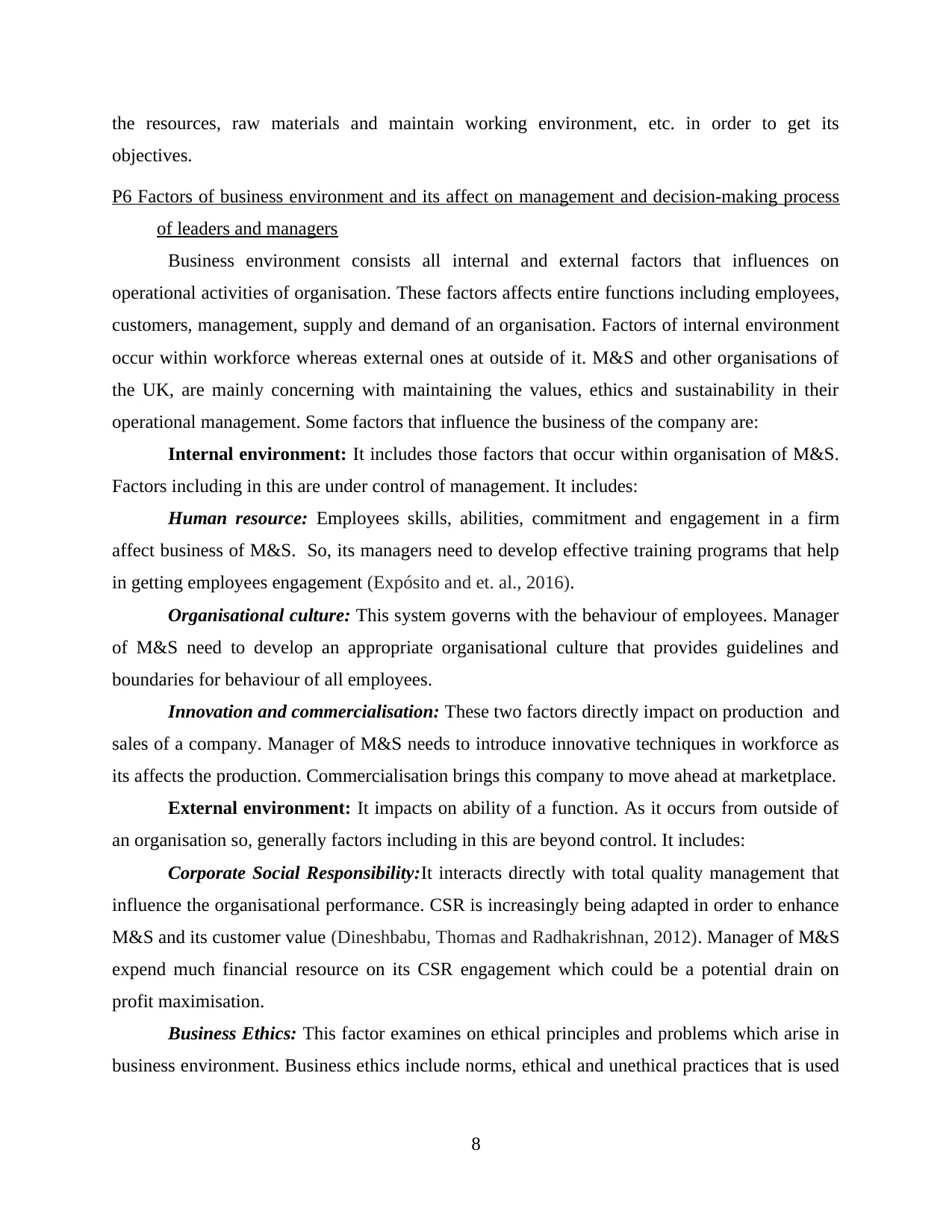
the resources, raw materials and maintain working environment, etc. in order to get its
objectives.
P6 Factors of business environment and its affect on management and decision-making process
of leaders and managers
Business environment consists all internal and external factors that influences on
operational activities of organisation. These factors affects entire functions including employees,
customers, management, supply and demand of an organisation. Factors of internal environment
occur within workforce whereas external ones at outside of it. M&S and other organisations of
the UK, are mainly concerning with maintaining the values, ethics and sustainability in their
operational management. Some factors that influence the business of the company are:
Internal environment: It includes those factors that occur within organisation of M&S.
Factors including in this are under control of management. It includes:
Human resource: Employees skills, abilities, commitment and engagement in a firm
affect business of M&S. So, its managers need to develop effective training programs that help
in getting employees engagement (Expósito and et. al., 2016).
Organisational culture: This system governs with the behaviour of employees. Manager
of M&S need to develop an appropriate organisational culture that provides guidelines and
boundaries for behaviour of all employees.
Innovation and commercialisation: These two factors directly impact on production and
sales of a company. Manager of M&S needs to introduce innovative techniques in workforce as
its affects the production. Commercialisation brings this company to move ahead at marketplace.
External environment: It impacts on ability of a function. As it occurs from outside of
an organisation so, generally factors including in this are beyond control. It includes:
Corporate Social Responsibility:It interacts directly with total quality management that
influence the organisational performance. CSR is increasingly being adapted in order to enhance
M&S and its customer value (Dineshbabu, Thomas and Radhakrishnan, 2012). Manager of M&S
expend much financial resource on its CSR engagement which could be a potential drain on
profit maximisation.
Business Ethics: This factor examines on ethical principles and problems which arise in
business environment. Business ethics include norms, ethical and unethical practices that is used
8
objectives.
P6 Factors of business environment and its affect on management and decision-making process
of leaders and managers
Business environment consists all internal and external factors that influences on
operational activities of organisation. These factors affects entire functions including employees,
customers, management, supply and demand of an organisation. Factors of internal environment
occur within workforce whereas external ones at outside of it. M&S and other organisations of
the UK, are mainly concerning with maintaining the values, ethics and sustainability in their
operational management. Some factors that influence the business of the company are:
Internal environment: It includes those factors that occur within organisation of M&S.
Factors including in this are under control of management. It includes:
Human resource: Employees skills, abilities, commitment and engagement in a firm
affect business of M&S. So, its managers need to develop effective training programs that help
in getting employees engagement (Expósito and et. al., 2016).
Organisational culture: This system governs with the behaviour of employees. Manager
of M&S need to develop an appropriate organisational culture that provides guidelines and
boundaries for behaviour of all employees.
Innovation and commercialisation: These two factors directly impact on production and
sales of a company. Manager of M&S needs to introduce innovative techniques in workforce as
its affects the production. Commercialisation brings this company to move ahead at marketplace.
External environment: It impacts on ability of a function. As it occurs from outside of
an organisation so, generally factors including in this are beyond control. It includes:
Corporate Social Responsibility:It interacts directly with total quality management that
influence the organisational performance. CSR is increasingly being adapted in order to enhance
M&S and its customer value (Dineshbabu, Thomas and Radhakrishnan, 2012). Manager of M&S
expend much financial resource on its CSR engagement which could be a potential drain on
profit maximisation.
Business Ethics: This factor examines on ethical principles and problems which arise in
business environment. Business ethics include norms, ethical and unethical practices that is used
8
Paraphrase This Document
Need a fresh take? Get an instant paraphrase of this document with our AI Paraphraser
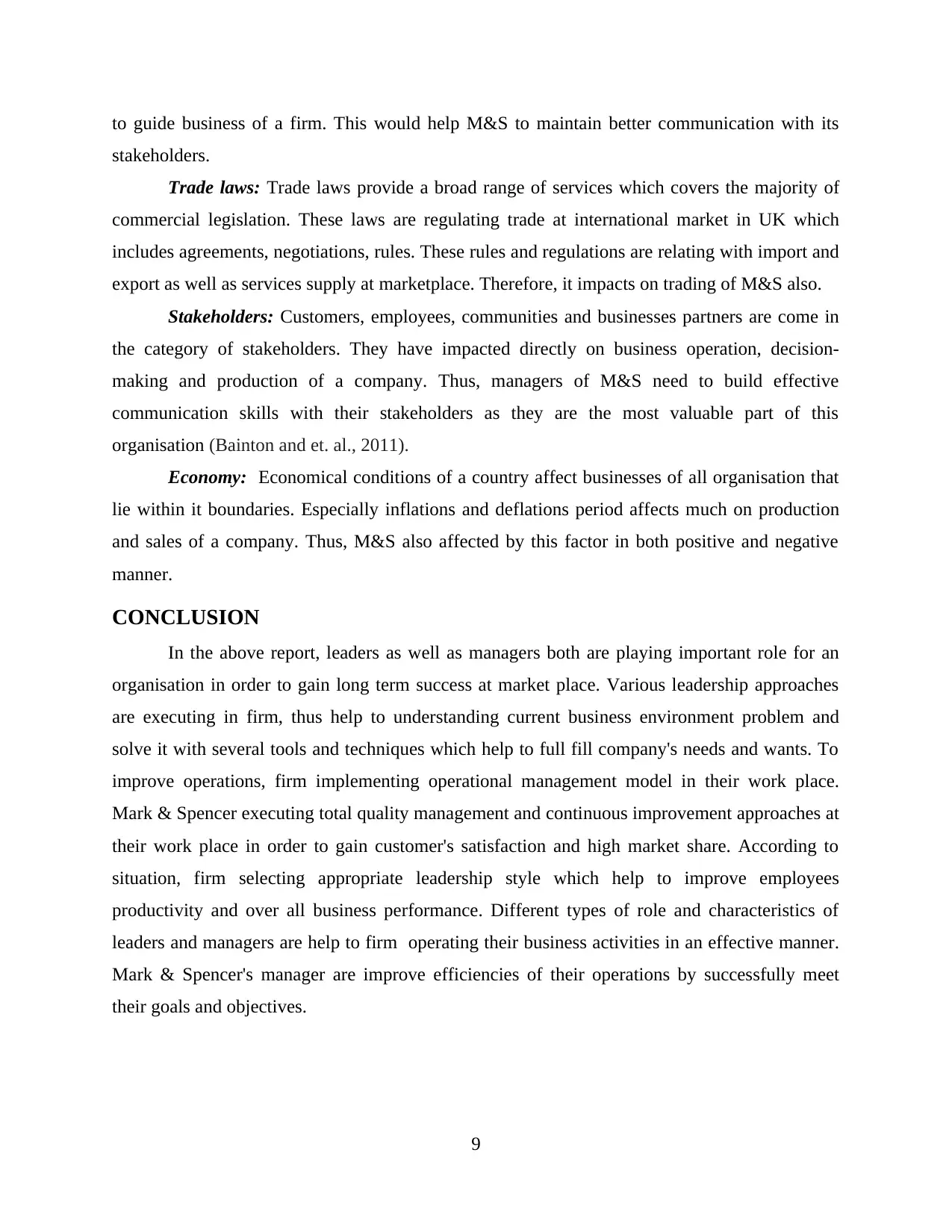
to guide business of a firm. This would help M&S to maintain better communication with its
stakeholders.
Trade laws: Trade laws provide a broad range of services which covers the majority of
commercial legislation. These laws are regulating trade at international market in UK which
includes agreements, negotiations, rules. These rules and regulations are relating with import and
export as well as services supply at marketplace. Therefore, it impacts on trading of M&S also.
Stakeholders: Customers, employees, communities and businesses partners are come in
the category of stakeholders. They have impacted directly on business operation, decision-
making and production of a company. Thus, managers of M&S need to build effective
communication skills with their stakeholders as they are the most valuable part of this
organisation (Bainton and et. al., 2011).
Economy: Economical conditions of a country affect businesses of all organisation that
lie within it boundaries. Especially inflations and deflations period affects much on production
and sales of a company. Thus, M&S also affected by this factor in both positive and negative
manner.
CONCLUSION
In the above report, leaders as well as managers both are playing important role for an
organisation in order to gain long term success at market place. Various leadership approaches
are executing in firm, thus help to understanding current business environment problem and
solve it with several tools and techniques which help to full fill company's needs and wants. To
improve operations, firm implementing operational management model in their work place.
Mark & Spencer executing total quality management and continuous improvement approaches at
their work place in order to gain customer's satisfaction and high market share. According to
situation, firm selecting appropriate leadership style which help to improve employees
productivity and over all business performance. Different types of role and characteristics of
leaders and managers are help to firm operating their business activities in an effective manner.
Mark & Spencer's manager are improve efficiencies of their operations by successfully meet
their goals and objectives.
9
stakeholders.
Trade laws: Trade laws provide a broad range of services which covers the majority of
commercial legislation. These laws are regulating trade at international market in UK which
includes agreements, negotiations, rules. These rules and regulations are relating with import and
export as well as services supply at marketplace. Therefore, it impacts on trading of M&S also.
Stakeholders: Customers, employees, communities and businesses partners are come in
the category of stakeholders. They have impacted directly on business operation, decision-
making and production of a company. Thus, managers of M&S need to build effective
communication skills with their stakeholders as they are the most valuable part of this
organisation (Bainton and et. al., 2011).
Economy: Economical conditions of a country affect businesses of all organisation that
lie within it boundaries. Especially inflations and deflations period affects much on production
and sales of a company. Thus, M&S also affected by this factor in both positive and negative
manner.
CONCLUSION
In the above report, leaders as well as managers both are playing important role for an
organisation in order to gain long term success at market place. Various leadership approaches
are executing in firm, thus help to understanding current business environment problem and
solve it with several tools and techniques which help to full fill company's needs and wants. To
improve operations, firm implementing operational management model in their work place.
Mark & Spencer executing total quality management and continuous improvement approaches at
their work place in order to gain customer's satisfaction and high market share. According to
situation, firm selecting appropriate leadership style which help to improve employees
productivity and over all business performance. Different types of role and characteristics of
leaders and managers are help to firm operating their business activities in an effective manner.
Mark & Spencer's manager are improve efficiencies of their operations by successfully meet
their goals and objectives.
9
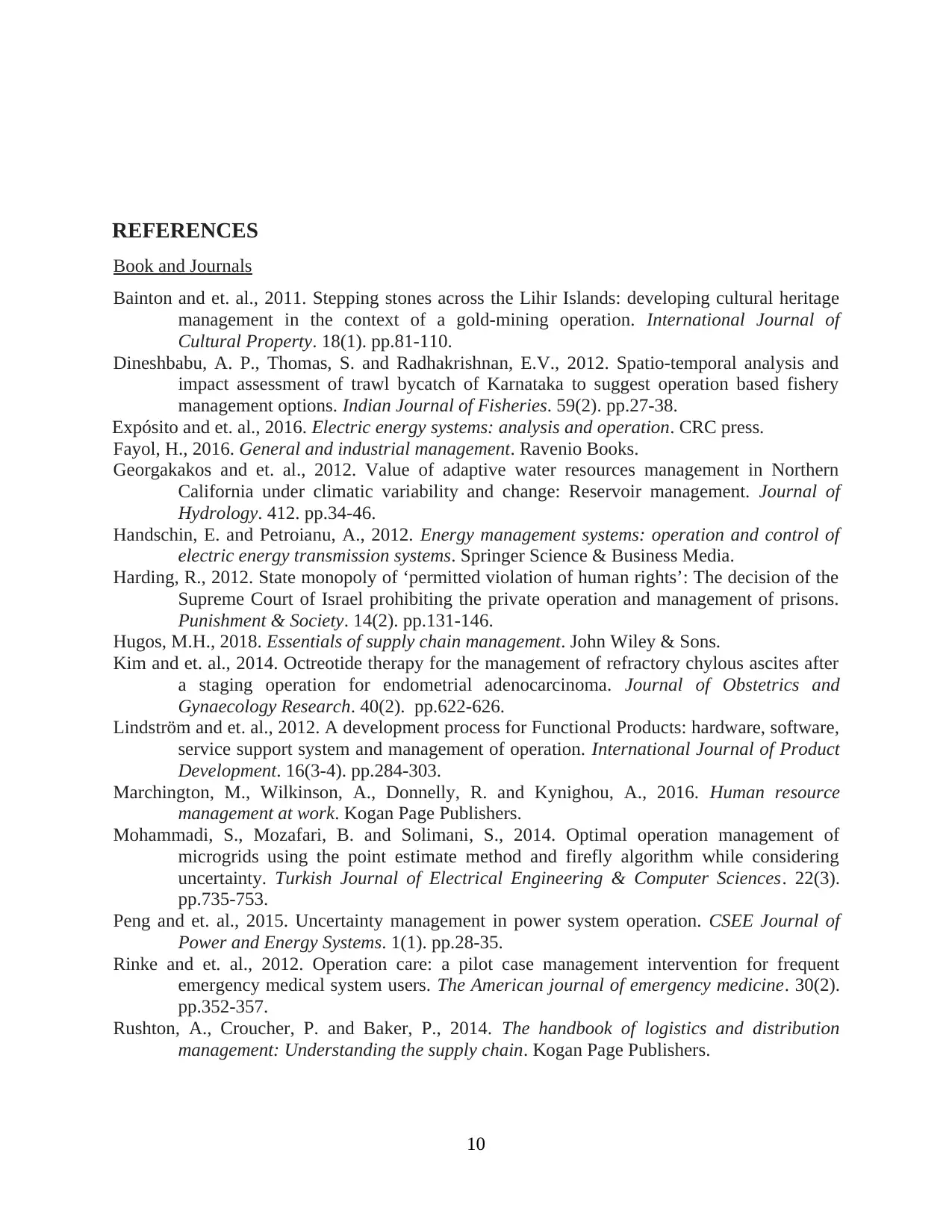
REFERENCES
Book and Journals
Bainton and et. al., 2011. Stepping stones across the Lihir Islands: developing cultural heritage
management in the context of a gold-mining operation. International Journal of
Cultural Property. 18(1). pp.81-110.
Dineshbabu, A. P., Thomas, S. and Radhakrishnan, E.V., 2012. Spatio-temporal analysis and
impact assessment of trawl bycatch of Karnataka to suggest operation based fishery
management options. Indian Journal of Fisheries. 59(2). pp.27-38.
Expósito and et. al., 2016. Electric energy systems: analysis and operation. CRC press.
Fayol, H., 2016. General and industrial management. Ravenio Books.
Georgakakos and et. al., 2012. Value of adaptive water resources management in Northern
California under climatic variability and change: Reservoir management. Journal of
Hydrology. 412. pp.34-46.
Handschin, E. and Petroianu, A., 2012. Energy management systems: operation and control of
electric energy transmission systems. Springer Science & Business Media.
Harding, R., 2012. State monopoly of ‘permitted violation of human rights’: The decision of the
Supreme Court of Israel prohibiting the private operation and management of prisons.
Punishment & Society. 14(2). pp.131-146.
Hugos, M.H., 2018. Essentials of supply chain management. John Wiley & Sons.
Kim and et. al., 2014. Octreotide therapy for the management of refractory chylous ascites after
a staging operation for endometrial adenocarcinoma. Journal of Obstetrics and
Gynaecology Research. 40(2). pp.622-626.
Lindström and et. al., 2012. A development process for Functional Products: hardware, software,
service support system and management of operation. International Journal of Product
Development. 16(3-4). pp.284-303.
Marchington, M., Wilkinson, A., Donnelly, R. and Kynighou, A., 2016. Human resource
management at work. Kogan Page Publishers.
Mohammadi, S., Mozafari, B. and Solimani, S., 2014. Optimal operation management of
microgrids using the point estimate method and firefly algorithm while considering
uncertainty. Turkish Journal of Electrical Engineering & Computer Sciences. 22(3).
pp.735-753.
Peng and et. al., 2015. Uncertainty management in power system operation. CSEE Journal of
Power and Energy Systems. 1(1). pp.28-35.
Rinke and et. al., 2012. Operation care: a pilot case management intervention for frequent
emergency medical system users. The American journal of emergency medicine. 30(2).
pp.352-357.
Rushton, A., Croucher, P. and Baker, P., 2014. The handbook of logistics and distribution
management: Understanding the supply chain. Kogan Page Publishers.
10
Book and Journals
Bainton and et. al., 2011. Stepping stones across the Lihir Islands: developing cultural heritage
management in the context of a gold-mining operation. International Journal of
Cultural Property. 18(1). pp.81-110.
Dineshbabu, A. P., Thomas, S. and Radhakrishnan, E.V., 2012. Spatio-temporal analysis and
impact assessment of trawl bycatch of Karnataka to suggest operation based fishery
management options. Indian Journal of Fisheries. 59(2). pp.27-38.
Expósito and et. al., 2016. Electric energy systems: analysis and operation. CRC press.
Fayol, H., 2016. General and industrial management. Ravenio Books.
Georgakakos and et. al., 2012. Value of adaptive water resources management in Northern
California under climatic variability and change: Reservoir management. Journal of
Hydrology. 412. pp.34-46.
Handschin, E. and Petroianu, A., 2012. Energy management systems: operation and control of
electric energy transmission systems. Springer Science & Business Media.
Harding, R., 2012. State monopoly of ‘permitted violation of human rights’: The decision of the
Supreme Court of Israel prohibiting the private operation and management of prisons.
Punishment & Society. 14(2). pp.131-146.
Hugos, M.H., 2018. Essentials of supply chain management. John Wiley & Sons.
Kim and et. al., 2014. Octreotide therapy for the management of refractory chylous ascites after
a staging operation for endometrial adenocarcinoma. Journal of Obstetrics and
Gynaecology Research. 40(2). pp.622-626.
Lindström and et. al., 2012. A development process for Functional Products: hardware, software,
service support system and management of operation. International Journal of Product
Development. 16(3-4). pp.284-303.
Marchington, M., Wilkinson, A., Donnelly, R. and Kynighou, A., 2016. Human resource
management at work. Kogan Page Publishers.
Mohammadi, S., Mozafari, B. and Solimani, S., 2014. Optimal operation management of
microgrids using the point estimate method and firefly algorithm while considering
uncertainty. Turkish Journal of Electrical Engineering & Computer Sciences. 22(3).
pp.735-753.
Peng and et. al., 2015. Uncertainty management in power system operation. CSEE Journal of
Power and Energy Systems. 1(1). pp.28-35.
Rinke and et. al., 2012. Operation care: a pilot case management intervention for frequent
emergency medical system users. The American journal of emergency medicine. 30(2).
pp.352-357.
Rushton, A., Croucher, P. and Baker, P., 2014. The handbook of logistics and distribution
management: Understanding the supply chain. Kogan Page Publishers.
10
⊘ This is a preview!⊘
Do you want full access?
Subscribe today to unlock all pages.

Trusted by 1+ million students worldwide
1 out of 13
Related Documents
Your All-in-One AI-Powered Toolkit for Academic Success.
+13062052269
info@desklib.com
Available 24*7 on WhatsApp / Email
![[object Object]](/_next/static/media/star-bottom.7253800d.svg)
Unlock your academic potential
Copyright © 2020–2025 A2Z Services. All Rights Reserved. Developed and managed by ZUCOL.




